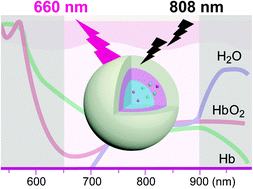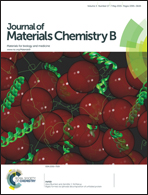An upconversion nanoprobe operating in the first biological window†
Abstract
Upconversion nanoparticles capable of converting low-energy excitation into higher-energy emission have been proved to be useful for sensitive biodetection due to the largely eliminated background autofluorescence and light scattering effects. However, the existing techniques have been constrained due to the absorption of excitation and emission light by water and hemoglobin in biological settings that typically result in low light penetration depth and potential thermal damage to biological samples. In this work, a core–shell–shell nanostructure is described to realize photon upconversion in the first biological spectral window (650–900 nm) where the absorption of water and the biological specimen is minimal. We synthesized core–shell–shell nanoparticles with small feature size (∼30 nm) that display dominant emission in the far red (660 nm) spectral region upon excitation at 808 nm. The as-synthesized core–shell–shell nanoparticles were further developed as optical bioprobes that offer sensitive biodetection in the presence of tissue wrapping.


 Please wait while we load your content...
Please wait while we load your content...